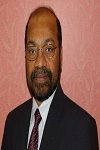
Vijayan K. Asari
University of Dayton, USA
Title: Automatic object recognition and tracking in complex environmental conditions
Biography
Biography: Vijayan K. Asari
Abstract
The amazing progress in sensor technology has made it possible for capturing images of Giga bytes in frame size at a reasonable frame rate in wide area motion imagery (WAMI) processing scenario. Automatic detection, tracking and identification of objects in this imagery in real time are becoming a necessity for security and surveillance applications. Feature extraction and classification of moving objects in WAMI data is challenging as the size of the objects in the image may be too small and they appear in different viewing angles and in varying environmental conditions. We present a new framework for detection and tracking of such low resolution objects in wide area imagery. The motivation behind the development of this algorithm is to utilize the entire information that is available about the object of interest in the detection and tracking processes. The proposed method makes use of a dense version of localized histogram of gradients on the difference images. A Kalman filter based predictive mechanism is employed in the tracking methodology. The feature based tracking mechanism can track all the moving objects. The robustness of the proposed methodology is illustrated with the help of detection and tracking of several objects of interest in varying situations. It is observed that the new method can even track pedestrians in WAMI data. We also present the effect of our shadow illumination and super-resolution techniques to improve object detection and tracking in very long range videos. The processing steps include stitching of images captured by multiple sensors, video stabilization and distortion correction, frame alignment for registration and moving object detection, tracking of multiple objects and humans in the motion imagery, classification of objects and identification of humans in the scene, and communication of large image data and decisions to multiple destinations. In addition, information extracted from video streams captured by sensors located at different regions could also be used for accurate decision making.

